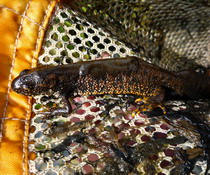The Great Crested Newt Survey Experience
Great crested newts are fascinating creatures. Since joining Wild Frontier Ecology it has been my privilege to undertake many great crested newt surveys, looking for these beautiful amphibians. The female is the larger reaching up to 170mm, but it is the smaller male which is the real beauty with his jagged crest. Both are dark from above, but sometimes as they flick away through the water you get a fleeting glimpse of their fiery orange or yellow belly. The dragon is alive and well and can be seen living in English ponds! To me part of the magic is that many people will have never seen one. Although great crested newts are fairly widespread, and can be found in rural, suburban and urban areas, they often go unnoticed. They skulk away in quiet unmanaged places, or hide away in the depths of ponds.
Last summer WFE undertook extensive great crested newt surveys, we surveyed 257 ponds right across Norfolk. All these ponds were within the buffer of a linear infrastructure development, and therefore required survey. Four survey visits to each pond are required to establish whether great crested newt are present. Logistically it was a challenge to ensure all ponds were fully surveyed within the correct time period, but one that we were delighted to rise to.

Great Crested Newt, caught by Kelly.
Although we had calculated a Habitat Suitability Index for each of the waterbodies, newt occurrence cannot be predicted so simply. Whilst I might think an area truly lovely, newts can be nowhere to be found, yet an unpromising tiny garden pond suddenly yields a medium sized population. In this job you never know what you will find next. Last Spring I was to be found out and about in the farmyards, fields and gardens of Norfolk. Fortunately we were blessed with plenty of fine weather, so it was a joy to wander from pond to pond, clipboard and dip net in hand. Although it is of course, never that simple.
Not all ponds are easily accessible. On private land, away from the footpaths the terrain is not always straight forward, dense woodland always makes finding even a large pond difficult and a small one far more of a challenge! The modern technology of GPS fails as soon as trees obscure the sky. It’s up to me, and me alone to navigate the dense bramble and work out where the pond is and where I’ve ended up. Even ponds in the middle of arable fields come with their own unique set of challenges. You might be able to stroll up to within 2 or 3 meters of the water, then dense hawthorn, barbed wire, or even just an entanglement of fallen willow make getting oneself and the awkward dip net to the water’s edge nearly impossible! I might not be the fittest, strongest or most knowledgeable member of the WFE team, but as the smallest I am at least well placed to wriggle through the smallest of gaps! Trousers, shirts and wellies, are inevitably by the end of the season all full of snags and holes.
Then of course there is the local livestock; cows, horses, sheep, pigs. Their ponds are often easy to access as they have been in first. Unfortunately, they all seem to delight on sneaking up on you whilst your attention is focused into the ponds murky water. As soon as a land owner tells me there are ‘friendly’ animals in a field I am at once on my guard, for these are precisely the inquisitive animals like nothing better than to come and investigate. And a ‘friendly’ herd of bullocks all vying to examine me and my net is to say the least a little unnerving!
In late spring and early summer as the sun went down, and most people returned home, I set out once again, with powerful torches in hand, to retrace my daytime steps. Torch surveys by night allow a fascinating view of pond life. Gone are the daytime reflections allowing a view into a newt’s world. Steadily the water is scanned with the powerful torch beam and sightings are methodically noted down. Sometimes nothing can be seen in the murky depths; sometimes the merest flick of a tail gives the newts away as they head for cover. On some days however, we’re rewarded with the wonder of a clear view as, seemingly untroubled, they proceed about their business!
By night the Norfolk countryside is a whole different world; the wildlife is out and about. Badger, fox, hedgehog and deer have all come upon me in the darkness only to panic in my torch’s fierce glow. For the local people our nocturnal habits are somewhat confusing. I had to smile when on one occasion I returned to a site for a subsequent visit to find out that startled locals had suspected me of being a UFO. It is however, well worth the late nights to ensure a job well done.
As spring blooms once again, now is the time of year when WFE start getting lots of requests for great crested newt surveys. I have already been out and about, conducting waterbody assessments and the first survey visits at sites up and down the country. Now I’m eagerly anticipating what the next visits might bring!
For further information on great crested newt surveys take a look at the amphibian page or contact us.
Susie

Susannah Dickinson
